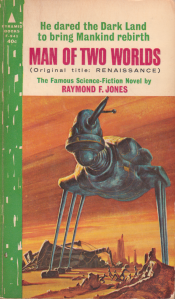The Book: The Alien by Raymond F. Jones. Originally published in 1951, the edition read was published by Belmont in 1966.
The Setting: Earth, space, a distant planet, in the future.
The Story: Scientists bring an alien creature back to life and then fight said alien creature when it takes over planet Earth with charisma and mind powers.
The Science: Space archaeologists find the craft holding the life force of the alien, but have to decipher the language to learn more. Which they do, using a made up linguistic principle called Carnovon’s frequency. Which I think has to do with the frequency of concepts in a language, but it’s kind of unfortunate that the author didn’t explore actual properties of language. Also, that the so called language experts didn’t realize that one set of characters represented numbers and mathematical principles. It took the main character to realize that.
The Reaction: Not a fan. I had hope for the book, briefly, early on, but that hope was dashed for good when a motley crew of scientists who hate everyone else fight their way out of the solar system and then procure amazing mind powers. The societal side of the story is very unfortunate. Not a classic of science fiction, despite what the cover asserts.
The Cover: No cover art credit. A bunch of folks in bubble helmets look at a great big naked guy. Of note is the fact that there are two women on the cover and only one woman in the entire book. And I don’t think she, an important scientist, was running around in that outfit.
Next Up: “Son of Two Worlds,” by Edmond Hamilton.


